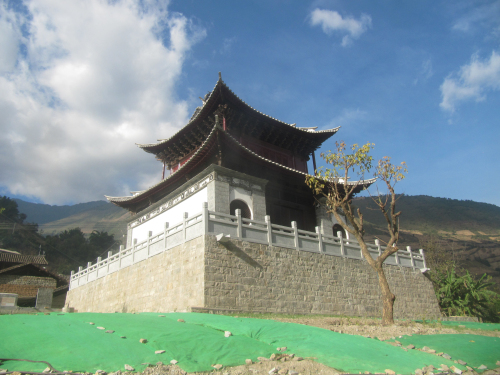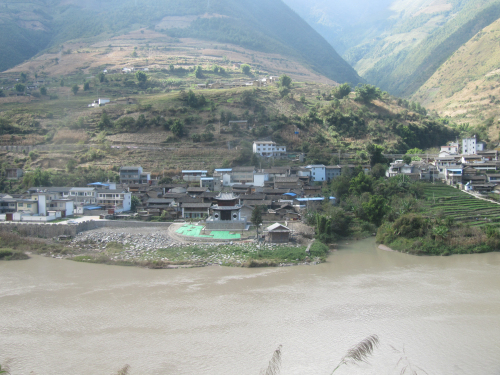Feilong Bridge and Wangjiang Tower in Yunlong County, Dali
English Name: Wangjiang Tower
Chinese Name: 望江楼 (Wàngjiāng Lóu)
Location: Yunlong County (云龙县, Yúnlóng Xiàn), Dali (大理, Dàlǐ), Yunnan Province (云南省, Yúnnán Shěng)
Cultural Heritage Level: Cultural Relic Protection Unit of Yunlong County
Notable Attraction: Feilong Bridge (飞龙桥, Fēilóng Qiáo)
Overview
Wangjiang Tower is located on the eastern bank of the Lancang River (澜沧江, Láncāng Jiāng) in the Miaowei Village Committee of Miaowei Township, Yunlong County, Dali. According to historical records, Wangjiang Tower was constructed by Li Yushu (李玉树, Lǐ Yùshù), a general under Du Wenxiu (杜文秀, Dù Wénxiù), a leader of the Hui people’s uprising during the Qing Dynasty, between the reigns of Emperor Xianfeng and Emperor Tongzhi. Built simultaneously with the Feilong Bridge in the second year of Tongzhi (1863), it serves as one of the main architectural features at the western end of the bridge, covering an area of 153.41 square meters.
Architectural Features
Wangjiang Tower is situated at the end of the main axis of the original Feilong Bridge, constructed in two levels. This traditional timber structure features a green tiled roof with a heavy eave design and stands approximately 12.1 meters tall from the foundation to the apex.
First Floor
- Dimensions: The first floor has three bays in width and three bays in depth.
- Entrances: Each side has a solid wooden door, which also serves as the entrance for crossing the original Feilong Bridge.
- Windows: There are circular windows on the east wall of the north and south rooms. The west wall features brick carvings resembling riverbanks, while the remaining walls are constructed of rammed earth.
- Staircase: A wooden staircase runs straight from east to west.
- Inscriptions: The interior walls are adorned with 13 stone inscriptions.
Second Floor
- Dimensions: The second floor also features three bays in width and depth.
- Windows: Four wooden partition windows open on all sides.
- Railings: Wooden railings are fitted at the stairway openings on the east and north sides.
- Decorations: The interior showcases a statue of Guanyin made of colored clay, displayed in the corridor near the west-facing window.
The roof beams support the floor panels, and both levels exhibit distinctive local construction techniques with intricately carved brackets. The roof features a series of ornamental brackets, reflecting local architectural characteristics.
Historical Significance
Wangjiang Tower is the only well-preserved main building remaining after the destruction of the Feilong Bridge. Its unique construction techniques and architectural style have several noteworthy characteristics:
- Traditional Layout: It retains the traditional Bai ethnic architectural layout from the Qing Dynasty.
- Distinctive Features: The roof, ridge, and decorative elements such as beast sculptures and floral carvings exhibit distinct Bai architectural and decorative artistry.
- High Construction Level: The upper eaves utilize bracket construction, employing large timber materials with refined craftsmanship.
- Artistic Value: The exquisite wooden and brick carvings present intricate patterns, showcasing fine craftsmanship.
The thirteen stone inscriptions preserved within the tower provide valuable evidence for studying the Du Wenxiu uprising, holding significant historical and research value. Additionally, the poem “Chijiangqiao Fu” (池江桥赋) inscribed at Wangjiang Tower represents a rare literary gem from Yunlong County.
Wangjiang Tower is located on a vital section of the ancient postal route in Yunlong County during the Ming Dynasty and has historically been a contested fortress. It symbolizes the historical transformations of the area, holding deep emotional and commemorative significance for the local people.
Protection Status
In 1987, Wangjiang Tower was designated as a Cultural Relic Protection Unit in Yunlong County.
How to Get There
- By Bus: Regular bus services operate from Dali to Yunlong County. Look for local buses heading towards Miaowei Township.
- By Taxi: Taxis are available in Dali and can take you directly to Wangjiang Tower in Yunlong County.
- By Car: Renting a car is an excellent option for those who prefer flexibility. The drive offers scenic views along the way.
Travel Tips
- Dress Comfortably: Wear appropriate footwear for walking, as the area may require some exploration on foot.
- Respect the Site: Be mindful of the historical significance and avoid touching the inscriptions or carvings.
- Stay Hydrated: Bring water, especially during the warmer months, to stay refreshed while exploring.
- Photography: Capture the architectural beauty and the scenic views around the Lancang River; the location offers excellent photo opportunities.
- Timing Your Visit: Visiting during weekdays can help avoid crowds, allowing for a more peaceful experience.
Wangjiang Tower, along with the Feilong Bridge, provides visitors a glimpse into the rich cultural heritage and architectural beauty of Yunnan Province, making it a must-see attraction in Dali.

















